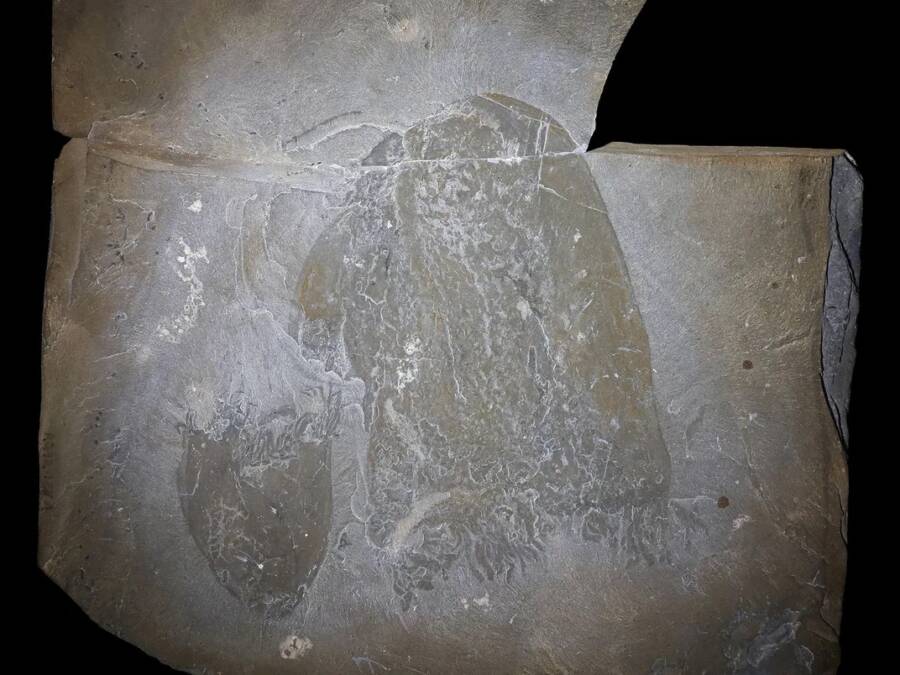Dating back to the Cambrian period, the fossils of Burgessomedusa phasmiformis were discovered in the Rocky Mountains of British Columbia.

Christian McCallAn artist’s rendition of Burgessomedusa phasmiformis swimming in the Cambrian sea.
Jellyfish are some of the strangest creatures on Earth, but they were also some of the earliest complex animals to occupy this planet.
Despite having been around seemingly forever, though, scientists have had difficulty tracing their origins and observing how jellyfish evolved over time. This is largely due to the fact that these soft-bodied creatures are 95 percent water — and often turn to goo before their bodies can be preserved.
But a new paper published in the journal Proceedings of the Royal Society B might offer researchers new insight into the ancient history of jellyfish. In the study, Jean-Bernard Caron, a paleontologist at the Royal Ontario Museum in Toronto, and other researchers detailed the discovery of jellyfish fossils that date back 500 million years, potentially making them the oldest swimming jellyfish fossils known to science.
“Sometimes in paleontology you know a great discovery as soon as it’s made in the field,” Royal Ontario Museum paleontologist and study author Joseph Moysiuk said to Smithsonian Magazine.
The jellyfish fossils were discovered in the Burgess Shale, a fossil-rich site in the Canadian Rockies that contains reef life dating back more than 508 million years, around the time of the Cambrian explosion. The site has become world-famous for containing the fossils of strange, soft-bodied animals from the early stages of evolution when mollusks and arthropods were starting to take shape.
Like previous soft-bodied creatures found at the site, these ancient jellyfish have been preserved with remarkable detail. Moysiuk said the jellyfish fossils are “quite large and obvious, even when they’re covered in mud.”
When paleontologists first found the fossils in the late 1980s and early 1990s, they immediately knew they had found ancient jellyfish. In all, they recovered 182 fossils from the Raymond Quarry in British Columbia — the only place where they have been found — but it took decades before researchers formally described them. The results were a new species of jellyfish, which researchers named Burgessomedusa phasmiformis.
According to the New York Times, the newly named species is part of a diverse group known as medusozoans, which researchers estimate emerged at least 600 million years ago and are still swimming the oceans today.
Paleontologists have been searching for Cambrian jellyfish fossils for well over a century, starting in 1911 when Charles Doolittle Walcott, administrator for the Smithsonian Institution, discovered what he believed to be a small, circular jellyfish in a disc-shaped fossil found in the Burgess Shale.
Later research revealed this fossil to be the mouth part of an arthropod known as Peytoia. Despite this mix-up, paleontologists remained convinced that jellyfish were among the animals that originated during the Cambrian period.
“Given their presumably ancient roots, we would expect to see jellyfish preserved alongside other Cambrian animals,” Moysiuk said.

Royal Ontario MuseumA slab containing two Cambrian specimens with their tentacles preserved.
Previous research may have found evidence of medusozoans in other sites as well — specifically, in a 2007 study from University of Kansas researcher Bruce Lieberman which examined a 505-million-year-old jellyfish found in Utah, and in a 2016 study from another team of paleontologists describing a 521-million-year-old jellyfish found in China’s Yunnan Province.
However, the new study suggests that these previous discoveries were not, in fact, medusozoan jellyfish but rather comb jellies, which belong to a different phylum and push themselves through the water with hundreds of tiny cilia rather than by pumping their bell-shaped bodies.
Although comb jellies and jellyfish are superficially similar, and these discoveries were equally ancient, there is a distinct difference between them.
That said, not all researchers are convinced by this new assessment. In fact, Lieberman has said that the new paper lacks compelling evidence to connect the previous discoveries to comb jellies.
“I’ve been working with the description and analysis of soft-bodied fossils like these for decades, and [the Utah fossils] are among the best-preserved specimens that I’ve ever encountered,” he said. He added that he is confident that the Utah and China fossils are most assuredly jellyfish and not comb jellies.
Regardless, Lieberman said the new paper “really adds to the compelling body of evidence indicating that medusozoans, which are a really important clade in the oceans today, were already established by the time of the Cambrian period.”
Researchers believe that Burgessomedusa‘s body measured nearly eight inches long, making it among some of the largest creatures around during its time. It also shares numerous characteristics with various modern jellyfish, but it doesn’t quite align with any of them on a 1:1 scale.
“Burgessomedusa shares features with multiple modern jellyfish groups but doesn’t fit neatly into any of them,” Moysiuk said. Its body is similar to modern box jellyfish, but its tentacles are closer to moon jellies. These similarities, Moysiuk suggested, could indicate that Burgessomedusa was a common ancestor from which many modern jellyfish diverged.
Like modern jellyfish, Burgessomedusa also lacked eyes, but it was likely still a top predator in its day. Evidence also suggests that it was able to hunt relatively large prey, as one specimen was preserved with a trilobite inside its bell.
“Burgessomedusa represents one more major animal body plan that can trace its roots back to the Cambrian,” Moysiuk said, “a striking and humbling reminder of how much biodiversity had already taken shape by half a billion years ago.”
After learning about these ancient jellyfish, read about a newly discovered jellyfish species with 24 eyes. Or, read about the giant phantom jellyfish observed by cruise liner guests off the coast of Antarctica.





